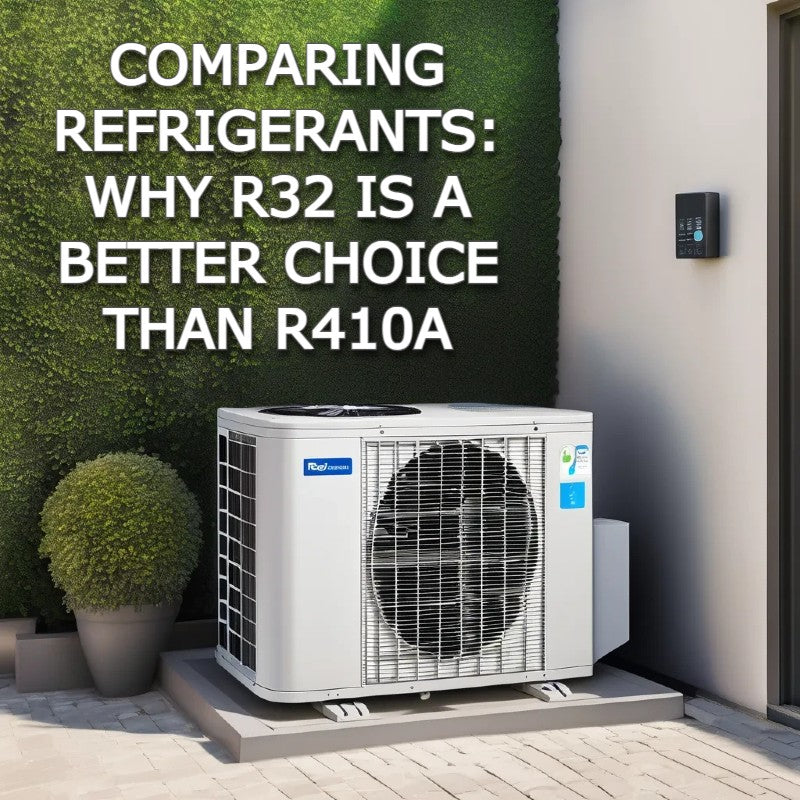As the HVAC industry transitions towards more environmentally friendly refrigerants, evaluating the properties and performance of different options becomes crucial for manufacturers, contractors, and consumers. Among the commonly used refrigerants, R32 and R410A stand out, each with distinct advantages and disadvantages. This blog post highlights why R32 units are a superior choice compared to R410A, helping buyers make informed decisions about refrigerant selection for their HVAC systems.
R32 vs. R410A:
R32 and R410A are both HFC (hydrofluorocarbon) refrigerants used in air conditioning and heat pump systems. However, there are significant differences between them:
Environmental Impact:
- R32: Boasts a lower global warming potential (GWP) and zero ozone depletion potential (ODP), making it an environmentally friendly option.
- R410A: Has a much higher GWP, contributing more significantly to global warming.
Performance:
- R32: Exhibits better thermodynamic properties, leading to higher energy efficiency and improved system performance.
- R410A: While non-flammable, it does not match R32 in terms of energy efficiency.
Performance on Hot Days:
- R32: Maintains better performance in high ambient temperatures, ensuring efficient cooling even on hot days.
- R410A: Can struggle to provide effective cooling during extreme heat, leading to reduced comfort and higher energy consumption.
Safety:
- R32: Mildly flammable, requiring additional safety precautions during handling and installation.
- R410A: Non-flammable, simplifying safety measures but at the cost of higher environmental impact.
Service and Cost:
- R32: As R32 becomes more widely adopted, service and maintenance for systems using this refrigerant are becoming easier and more affordable.
- R410A: While service infrastructure is well-established, the higher environmental cost and impending regulations make it a less attractive long-term option.
- Environmental Impact: Low-GWP refrigerants like R32 are preferred for their reduced environmental footprint.
- Energy Efficiency: R32's superior thermodynamic properties lead to better system performance.
- Safety: While R32's flammability requires careful handling, its benefits often outweigh the risks.
- Service and Cost: The growing availability and decreasing cost of R32 services make it a practical choice for the future.

Discover Top-Grade Air Conditioners: View Our Products Today
Key Considerations for Refrigerant Selection:
When selecting refrigerants for HVAC applications, consider the following factors:
Regulatory Compliance and Future Trends:
Stricter regulations worldwide are driving the shift towards low-GWP refrigerants like R32. Governments are implementing measures to reduce the use of high-GWP refrigerants, encouraging the adoption of environmentally friendly alternatives. Manufacturers, contractors, and consumers are increasingly choosing R32 to comply with regulations and support sustainability initiatives.
In conclusion, R32 emerges as a better option compared to R410A, thanks to its lower environmental impact, higher energy efficiency, and superior performance in hot weather. While safety considerations due to its mild flammability must be addressed, the benefits of R32 make it a compelling choice for modern HVAC systems. Additionally, as service and maintenance for R32 become easier and more affordable, it stands out as a practical and forward-thinking choice. By understanding the properties, performance, and regulatory implications of different refrigerants, stakeholders can make informed decisions that promote environmental sustainability and regulatory compliance. If you’re looking for an R32 product coming soon we suggest the Goodman 3 Ton 16.4 SEER2 R32 Air Conditioner Condenser.







